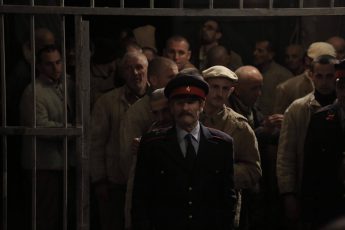A Lonely Search for Social Recognition
Tünde Skovrán’s Who I Am Not (2023)
Vol. 135 (May 2023) by Antonis Lagarias
In recent decades, the rise of identity politics has led to a shift in political theory and practice, which has also influenced contemporary documentaries. More and more films focus on people who, being part of what is defined as a social “minority” (typically groups of people united by their cultural, sexual, ethnic, or other differences), embark on a quest to better understand their own bodies and social or cultural identities. This gives rise to a new political field that attempts to demonstrate that the “normal” is in fact a cultural construction that guarantees the preservation of privileges for specific groups (most often composed of individuals who are male, straight, and white) in a society shaped to primarily serve their needs and interests. As a result, many documentaries turn to people who face different forms of social exclusion and actively try to change society by creating communities of support and solidarity.
In Who I Am Not, Romanian director Tünde Skovrán follows the lives of two black intersex individuals, Sharon-Rose and Dimakatso, who live in South Africa. “Intersex” is a term used to describe people born with bodies that have both female and male biological characteristics. The film examines how their non-binary gender affects their daily lives. Sharon-Rose has the appearance of a female person (and refers to herself using the she/her pronouns), has won female beauty contests, works for a large pharmaceutical company and lives in a comfortable middle-class apartment. When she realizes that her reproductive organs are not functioning properly, she finds out that she has both male and female chromosomes, a discovery that leads her to question her place in a world that favors binary distinctions between the sexes, and where a woman’s ability to bear children is considered crucial for a happy life. Dimakatso, on the other hand, is an activist whose appearance does not correspond to any traditional understanding of gender (and who seems to prefer the they/them pronouns). Rejected by most employees because of their ambiguous appearance, Dimakatso spends their days with their partner in a small house devoid of basic comforts. The film alternates between these two characters, and documents the various stages they must traverse in order to come to terms with their bodies. First, they undergo medical examinations, yielding biochemical proof of their intersexuality. Next, they try and embrace their social identity and raise public awareness. To do this, they both join an activist group for intersex people. Finally, they try to garner acceptance and support from friends, family, and partners.
The film focuses on the individual level of this issue, the need to understand one’s body and identity when faced with increased social exclusion. Its fundamental assumption throughout is that since both characters face personal and social issues related to their common “intersex” condition, their problems can be approached on an equal footing. This is visually addressed in a specific scene towards the middle of the film. The director includes a shot of Sharon-Rose diving into the bubbling water of her bathtub, only for Dimakatso to emerge in her place, a poetic image that visually underscores the fluidity of their bodies and genders, as well as the similarity of their respective experience. However, suggesting that the two characters are similar, if not interchangeable, fails to identify differences resulting from their respective social class. It is clear that Sharon-Rose leads a more “Westernized” life and hardly faces any financial issues. Her quest appears to mostly be about overcoming her intersexuality by confirming her female identity, finding a partner, and starting a family. Dimakatso, on the other hand, is more open to embrace their gender ambiguity even if it means being rejected by all the blue-collar jobs they apply for and facing dire financial problems. If the two characters share issues related to their “intersex” experience, many of the hardships they need to face in their everyday lives are fundamentally different.
Observing how the film opts to ignore their difference in wealth and social status, considering it secondary to their shared experience of intersexuality, reflects the abandonment of social class as a prime angle of social analysis. This issue is far from new. In political theory, while social class was a dominant analytical category over a long period of time, it has become secondary in recent decades. Today, communities tend to unite on the basis of their identity. They use this common ground for political actions focused on social recognition and equal rights. This approach often results in contradictions, as intra-group divisions persist, including different material conditions that greatly influence one’s needs and demands. Similarly, Who I Am Not never asks whether the evident differences between the two characters are inherited from their families’ social status, or whether they are a result of their appearance. Given that Dimakatso’s appearance does not easily correspond to any gender and, on the contrary, Sharon-Rose’s appearance closely resembles that of a biologically female person, one could assume that this is a determining factor when it comes to social inclusion. Equally, one could assume that Sharon-Rose, who was born into an affluent family, was able to avoid traumas related to her intersexuality, such as the gender-imposing surgery that Dimakatso had to undergo when they were born. This maybe explains Dimakatso’s outward anger and radicality, which contrast with Sharon-Rose’s more quiet composure. Viewers can only speculate.
Failure to address these issues creates a false unity that prevents the viewers from gaining insight into these complex social issues and instead leads to somewhat generic statements in favor of awareness, tolerance and acceptance that do not fully account for the implications of socially recognizing the existence of intersex people. In this sense, the film walks a thin line. On the one hand, it addresses a serious social problem that remains underrepresented in contemporary cinema. On the other, it blames ignorance and prejudice alone, suggesting that the solution to this problem lies in achieving personal enlightenment, rather than taking collective action against an oppressive social structure that constantly produces and reproduces different forms of inequality.
This problem becomes particularly evident in the film’s choice to avoid including details about the activist association where the two characters apparently met. Yet it’s obvious that these community networks of struggle and support are the only places where people of such different social status can meet. Instead, the film seeks to engage the viewers’ empathy by employing a number of visual metaphors that convey a sense of fragility and loneliness. In doing so, it adopts a more defensive stance as the characters’ quest for recognition becomes a quasi-spiritual journey, an attempt to overcome loneliness. Its individualistic approach lacks the analytical rigor that would explain the full scope of the social issue in question or explain the obvious divisions within groups united by some part of their identity. As a result, the film perhaps succeeds to appeal to a broad (international) audience, but only at the cost of ignoring the more subversive aspects of contemporary queer politics. That being said, the film does provide an interesting case of a current approach to documentary-making that departs from the premise that a deep dive into the intimate can shed light on wider social issues. It remains to be seen, however, whether such documentaries can be relevant not only to the usual audience of international festivals, but also to local communities, activist associations, and regional audiences.




Leave a Comment